
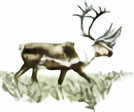

We experienced, on occasion such fantastic happenings that the experience could be shared only between us.If we related these anecdotes to our friends they would have heard us out and smiled tolerantly, and silently catalogued us as prime candidates for membership in the Liar's Club. It is public knowledge that the northland is the source of uncounted lies and often the unusual occurrence is not recorded, for the hunter knows that no one will believe it. Early November is the desirable time for the taking of furs. The pelts of foxes minks, and coyotes are prime. The colour is deep pristine, unbleached, and the pelt at full hair length. The lakes, rivers, and creeks are frozen over except in the vicinity of springs and where river currents thaw away the ice to form the natural habitat of otters. The travelling is easy now for the snow is only a few inches deep on land while the lake and river ice is either bare of snow or has just enough snow cover so that it is startlingly white and your moose-hide moccasins grip on the snow to make unhampered walking. It is time of lowering skies, soft winds, and moderate temperatures. There have been extremely cold nights to freeze up the lakes, but winter is taking a breather before another more intense arctic front, already poised to the north, begins to move down to the Cree Lake country.
Ab, out on the Rat Lake ice, was following the outer edge of a big stand of reeds and rushes frozen solidly in the ice and towering six or seven feet high. He could see through the reeds to the strip of ice on the other side; he saw four coyotes approaching on that side. His shot through the reeds missed, probably because the .22 lead slug was deflected by a reed. The coyotes milled about while he reached for his hunting knife to work out the empty cartridge that did not eject due to failure of the rifle's ejector mechanism. The tawny, tantalizingly close coyotes continued to move leisurely on their way so that they were beyond range when the rifle was once more loaded. At Cree Lake during such a season of the year, I had ascended a small creek on the ice and set a string of traps upstream along the watercourse that drained many small lakes into Caribou Lake.
As I walked I glanced over my shoulder to the spot on the ice where I had last seen the coyote. Keen young eyes picked him out there, a tiny speck that faded and reappeared like a gnat against snow. I continued to look at it as I walked and saw that it moved with me, parallel to my course. "Aha," I thought, "he is curious. He has probably never seen a human being in all his life and thinks I am a big game animal. Well, I will try a little experiment, play on his curiosity, and attempt to bring him back within range of my rifle." We paced each other steadily in this growing dusk, yet the lighting was such that the speck was visible from time to time all the way as we crossed the lake. Finally, as I watched him and he watched me, we neared the far shore. I had completed the planning of my strategy. Now I would attempt to outsmart him. I reached a place about two hundred yards from shore. As the coyote had appeared large and mature, chances were that it had seen caribou upon the ice in previous seasons. Now, I affected the slow awkward pacing that is characteristic of the caribou run when not thoroughly alarmed. I bent over from the waist and swung my legs in the long strides of the pacing caribou. I ran faster and faster, then straightened up and charged into the bush, circled toward the coyote into a thick stand of small spruce as fast as I could and flopped down on my belly, rifle ready and pointed out at the lake. Now I lay completely hidden, with a good view of the lake at a spot about fifty feet from where I had entered the bush. I hoped that the coyote would make for the spot where I had entered and thus cross my line of fire. I looked out on the lake. Sure enough, there he was looming larger coming as effortlessly as a breeze. Straight as a surveyors sighting, it seemed, he was drawn closer. I experienced a new and unique hunting thrill as he advanced without hesitation and no change of pace. Suddenly, I had him in my sights, then led the target and squeezed a shot. I did not lead him enough for he was hit through the hips. He pivoted then, biting at the red hot thing that burned through his hind quarters. A standing target now, the second shot, laid him dead twenty paces from where I lay hiding. I stepped on the ice and picked him up. The largest and heaviest male coyote I had ever seen, I dragged him up the hill and rolled him into the cabin. That night as I skinned him out, and before chucking the carcass outside, I made an incision through the stomach wall to see why the belly was abnormally distended. I found it so full of blueberries gleaned from the snow-free hilltops, that I felt that this coyote was hardly capable of eating more and he had not followed me because he had been hungry. He had been only fatally curious. On a very cold February afternoon, Ab hunted through some dense growth of young jackpine on the trail of a moose. He flushed a wiskey jack from a low bough and spotted its nest. Built at eye level, he peeped into the nest, pushed the down lining to one side and discovered three tiny eggs which were warm against his fingertip. He recovered the eggs and moved along the trail. "A strange bird," he said to me, "that will incubate its eggs at thirty below zero!" On certain sunny winter days when the temperature had moderated, as we snowshoed through the woods we sometimes saw in old tracks of wild animals in the snow, that the depressions contained tiny black specks, usually concentrated on the inner surface of the track that faced the sun. On close examination the specks were found to be tiny insect life, shiny black in colour, that moved on the snow as we watched. Many years later I learned that these minute creatures are called snow fleas. The Cree Lake country abounded in red squirrels. These active little fellows were everywhere.
The red squirrel for all its agility and mobility in the trees was outmanouvered by the pine marten. In prime squirrel country we found the marten's tracks in the snow one day. We saw where the tracks ended at the base of one tree to reappear in the snow below another tree to prove that it moved from tree to tree as did a squirrel. A slim beady-eyed serpentine animal, it preyed on red squirrels. There should have been more marten in this country, but this animal is one of the easiest to trap since it will go for any kind of bait and seems to have no suspicion at all of a steel trap. The otter possessed unsuspected strength. I caught one on a little creek above my outcamp on Caribou Lake. This fellow ripped apart the pen that I had constructed to hold the fish used for bait. It had dislodged all the poles of the pen, including the heavy drag to which the trap was anchored. It made off then under the ice of a small lake and became lost to us together with the trap and connecting chain. Ab with his usual ingenuity made a periscope using two pocket mirrors and a packing-case board. It worked well, too, so that we could peer for some distance under the ice. Although we spent most of one day in the search we were unsuccessful. We gave up too soon-we found the trap containing foot bones of an otter on the far shore of the lake the next autumn. Still attached to the heavy drag this otter had accomplished an incredible feat by pulling such a weight for such a long way. The ptarmigan while in flight often hurls itself into deep snow and tunnels under the snow crust in order to become sheltered from the cold and to hide from its enemies.
It seems that every living thing must, at least part of the time, be infested with parasites-fleas, ticks, lice-and such internal curses as tapeworms. In the Rat Creek country the moose were sometimes found to be so loaded with wood ticks that, as we split the skin along the belly when field dressing that animal, wood ticks were seen on the skin in such numbers that it made one a little sick to the stomach to see them, heads attached to skin, their bodies blood-loaded. I believe that there are cases where moose are so weakened by wood ticks that they are a factor in the demise of the big animals. Bears are tormented by flies, fleas, and the like and they are always scratching themselves or rubbing on trees. A bearskin rug on the floor of my outcamp was discovered to be alive with fleas, causing me to throw it outside for good. Squirrels and weasels are hosts to fleas and must stop to scratch frequently. When these animals are caught in a trap and freeze solid the fleas crawl out to the hair ends where they are rendered immovable. Strangely, these fleas will again become animated when the carcasses are brought into the cabin to thaw out. Wild ducks harbour big flat ticks that will run up your arm as you pluck off the duck's feathers. These insects lie so flat against your skin that they are as difficult to lift off as a bit of adhesive tape. The barren ground caribou seems to be the most susceptible of all big game animals to parasitic insects, for in addition to being host in winter to many larvae of the warble fly they may also carry a legion of nose botfly larvae and tapeworms. The cruel attacks on caribou by blackflies and mosquitoes in season must be seen to be believed; all the warm-blooded creatures suffer when the hair is thin and short in summer. Foxes sometimes escape the steel jaws of traps by a combination of chewing and tearing off the foot. Often they die after such an ordeal. Occasionally, they survive. Ab caught a fine dark silky female cross fox who had one front foot off at the wrist. The remainder of the foot had been in use, for a small pad had grown on the severed end. We guessed that this fox though disabled had made its way for some years on the stump of a front foot. A yearling bull moose blundered into one of my snares in a game trail. It had stepped into the loop by accident and stood caught around the front foot as I came up the trail. I shot it at once but found it to be only bones, skin, and hair and thus fit only for dog food. The moose had a broken front leg that it had suffered some months ago, for I found it to be knit together. This injury had so hampered the young moose that it could not move about to forage enough food. By the miracle of its tenacious hold on life, it had survived an unusually cold winter. Since it was early March when I caught it, I would have bet that it would somehow have survived the winter but for my snare. We were packing a big load of moose meat from far back in the hills down to the river where we could load it into the canoe and drift with the current all the way down to the home cabin. At one of our rest stops in the bush, we sat in a thick stand of jack pines at a spot where we had never sat before. It was the kind of place that possibly had never had a human visitor, for it was far from any lake or river. While we were sitting side by side on a fallen pine log, Ab reached over and picked up a round object from the caribou moss. It was the rusty bell from a dog harness, the kind used by Indians. "They put bells on their dog harnesses because they are afraid," Jim Buchan had said. "They believe that the sound will keep away the devil (Dishlini) when they are far out on the trail." Ab, familiar with placer-mining methods for gold from experience in British Columbia, made some experimental washings from time to time in the creeks that ran through rock country. He dug gravel from the base of rocks that were in the creek, taking material from the downstream side. He showed me black sand residues which he said were similar to those he had seen on the Fraser River, yet never a flake of free gold did we find. We took many rock samples in the outcroppings south of Cree Lake but found nothing of interest. We became aware, however, that if there is gold in that country it is bound up in solid rock, and mining development must be by big operators with financial backing of great magnitude. At the time I first entered the Northland, I discovered the parka, for this garment was not then in use for winter outerwear in the south. The northern parka, properly constructed, is without doubt the most superior outer garment that is available. North country dwellers, I found, wore parkas that were loose fitting and hung nearly to the knees, with a deep fur-trimmed hood that could be pulled over the face to keep the nose and chin from freezing in severe winter weather. These coats were not lined but were sewn from tough, light, windproof material. Usually a leather belt was worn around the waist, outside the parka, in which to tuck the belt axe and to hold the sheath for the hunting knife we carried over the right hip. In cold weather the hoarfrost collected at the shoulders from body moisture, but underneath we wore one or more woolen sweaters, a heavy bush shirt and a woolen undershirt of good quality. We found that heavy cumbersome clothing was not suited to us for we must be active and walk much of the time. We wore blue denim pants which were cheap, windproof, and tough. Under them one or two pairs of woolen drawers kept out the cold. Two pairs of moccasins and three pairs of socks completed our clothing except for moose-hide covered woolen mitts and a light windproof cap with ear flaps. In this clothing, we were comfortable and I never suffered a frozen finger or toe or frostbite to the face. We were continuously plagued by mice. Our fur storage was checked regularly to see that the mice were not using our furs for nest-building material. A pine marten pelt hanging on the cabin wall became ragged in one night. I discovered that a mouse had been stripping off the fur while we slept. Well known to us was their damage to dead and frozen foxes out on our traplines when they cut off expensive fur to line their nests. We always kept mousetraps as part of our equipment in order to eliminate them when they entered the cabins. Chris Timson told me how he had once stored a ten pound sack of sugar at one of his outcamps. He suspended the sack from the ridge pole inside the cabin on a string so that the mice could not get at it. When he returned next autumn only the empty sack remained. Mice had approached along the ridge pole, climbed down the string and cut a hole in the bottom corner of the sack so that sugar poured to the floor like sand in an hourglass. In summer mice were ever on the move on the forest floor. I have seen them swimming across creeks, riding high on air-filled fur.
We had a bone to pick with the manufacturers of our rifle cartridges. Far out on my trapline I experienced a hangfire. I shot at a ruffed grouse high in a tree with my .22. As the firing pin struck home there was no explosion. I lowered the rifle, was about to eject the faulty cartridge when it discharged. Ab out on the lake in forty-below weather shot at a coyote only two hundred yards away. The .30 calibre cartridge cracked strangely weak, and the projectile fell to the snow fifty yards away. One spring as we travelled Outside up the Beaver River, we found that the Crooked River water was so low that it was hardly navigable for our canoes. Frank, Martin, Ab, and I decided to continue upstream to the junction of the Green and Beaver Rivers and thence to Green Lake, there to hire an Indian and his team and wagon to transport us overland to Crooked Lake. As we passed up the quiet Green River we encountered homestead lands. One homesteader was seen unloading manure into the river. Around the bend a bloated dead cow floated with the current. I heard Frank curse softly. On long journeys over the frozen wilderness, we often experienced great thirst. Our dogs suffered thirst also for they frequently gulped snow. Far out on the big lakes we did on occasion chop a hole in the ice, lie face down and drink. |
| Deep River Fur Farm |
| Deep River Trapping Page |
| Deep River Fishing Page |
| My Norwegian Roots |
| Early Mink People Canada - Bowness |
| The Manager's Tale - Hugh Ross |
| Sakitawak Bi-Centennial - 200 Yrs. |
| Lost Land of the Caribou - Ed Theriau |
| The History of Buffalo Narrows |
| Hugh (Lefty) McLeod, Bush Pilot |
| George Greening, Bush Pilot |
| Timber Trails - History of Big River |
| Joe Anstett, Trapper |
| Bill Windrum, Bush Pilot |
| Face the North Wind - Art Karas |
| North to Cree Lake - Art Karas |
| Look at the Past - History Dore Lake |
| George Abbott Family History |
| These Are The Prairies |
| William A. A. Jay, Trapper |
| John Hedlund, Trapper |
| Deep River Photo Gallery |
| Cyril Mahoney, Trapper |
| Saskatchewan Pictorial History |
| Who's Who in furs - 1956 |
| Century in the Making - Big River |
| Wings Beyond Road's End |
| The Northern Trapper, 1923 |
| My Various Links Page |
| Ron Clancy, Author |
| Roman Catholic Church - 1849 |
| Frontier Characters - Ron Clancy |
| Northern Trader - Ron Clancy |
| Various Deep River Videos |
| How the Indians Used the Birch |
| Mink and Fish - Buffalo Narrows |
| Gold and Other Stories - Richards |
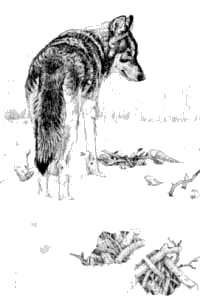 The furbearers then become seized by a frenzy of curiosity and wanderlust. Fox and coyote tracks are everywhere on the ice just out from shore. Every snag, rock, or other projection above the ice must be investigated. They are particularly attracted to animal smells at muskrat push-ups and house and beaver lodges and dams. So strong is the urge to travel that once in a while they swim across rivers where the ice has thawed away. At this time the wood's furry denizens take a brief vacation from the grim business of hunting their food and are apt to act a bit foolishly. The whole land has for them become a vast playground and out on the ice they are exploring a whole new range previously denied them. They revel so greatly in this changed environment that much of their usual shyness and caution vanishes for just a few days. This is the time that the greatest fur harvest takes place for many fall victim to the trappers' snares, traps, poison baits, and rifles.
The furbearers then become seized by a frenzy of curiosity and wanderlust. Fox and coyote tracks are everywhere on the ice just out from shore. Every snag, rock, or other projection above the ice must be investigated. They are particularly attracted to animal smells at muskrat push-ups and house and beaver lodges and dams. So strong is the urge to travel that once in a while they swim across rivers where the ice has thawed away. At this time the wood's furry denizens take a brief vacation from the grim business of hunting their food and are apt to act a bit foolishly. The whole land has for them become a vast playground and out on the ice they are exploring a whole new range previously denied them. They revel so greatly in this changed environment that much of their usual shyness and caution vanishes for just a few days. This is the time that the greatest fur harvest takes place for many fall victim to the trappers' snares, traps, poison baits, and rifles.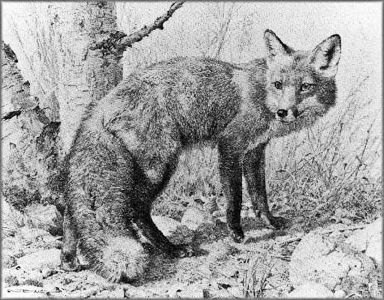 On my return downstream, I saw a red fox streak down the slope of the hill, nose to the ground, and come out on the creek ice, by which time I had dropped prone, my .22 repeating rifle cocked and ready. The fox kept its nose to the ice until it came upon my tracks. It faced me as it stopped, raised its head, and saw me at once. The shot, at long range, missed. I continued on to Caribou Lake. Then I stepped from a thick stand of black spruce onto Caribou Lake. There, I surprised a large coyote nosing about for mice in the long dead grass along the shore in a little bay. We saw each other simultaneously. My shot whistled over its speeding back as he legged it down the lake ice and out of sight to the north. I cut across the lake in disgust towards my outcamp on the other shore one and one-half miles distant. I walked at a brisk pace for the sun was down, the sky ominous and hung heavy with cloud. Darkness would come early that night.
On my return downstream, I saw a red fox streak down the slope of the hill, nose to the ground, and come out on the creek ice, by which time I had dropped prone, my .22 repeating rifle cocked and ready. The fox kept its nose to the ice until it came upon my tracks. It faced me as it stopped, raised its head, and saw me at once. The shot, at long range, missed. I continued on to Caribou Lake. Then I stepped from a thick stand of black spruce onto Caribou Lake. There, I surprised a large coyote nosing about for mice in the long dead grass along the shore in a little bay. We saw each other simultaneously. My shot whistled over its speeding back as he legged it down the lake ice and out of sight to the north. I cut across the lake in disgust towards my outcamp on the other shore one and one-half miles distant. I walked at a brisk pace for the sun was down, the sky ominous and hung heavy with cloud. Darkness would come early that night.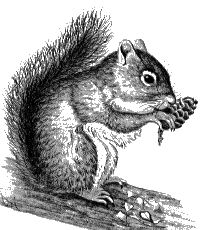 Great piles of pinecones remains were common in the bush where squirrels had fed for many generations. Although there was a market for their skins in those days, they were valued at only a few cents each, and their pelts were not easy to handle so we left them alone. We found that squirrels fed on mushrooms in summer. I once found a pine sapling decorated with mushrooms, where a squirrel had fastened his gatherings in the tree so that they would cure for storage. I had to shake the tree most vigorously to dislodge a single mushroom.
Great piles of pinecones remains were common in the bush where squirrels had fed for many generations. Although there was a market for their skins in those days, they were valued at only a few cents each, and their pelts were not easy to handle so we left them alone. We found that squirrels fed on mushrooms in summer. I once found a pine sapling decorated with mushrooms, where a squirrel had fastened his gatherings in the tree so that they would cure for storage. I had to shake the tree most vigorously to dislodge a single mushroom.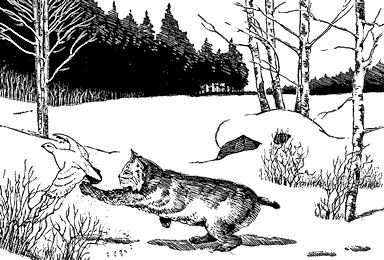 Along its path there are small holes in the snow at intervals where it has poked up its head from the tunnel to see what is going on. Apparently ptarmigan spend a good deal of time in these tunnels, for if you break them open with your foot, you discover many of their droppings along the way. The ptarmigan, difficult to see at best in winter, is practically invisible when its head protrudes from below the snow, so that you may nearly step on him before he thunders into the air and explodes powdery snow in your face. On a day when I craved a roast bird as a change from caribou meat, I shot one. On taking of the skin, I found a piece of spruce branch that was driven into the breast at least one inch. The bird had impaled itself on hurtling into the snow.
Along its path there are small holes in the snow at intervals where it has poked up its head from the tunnel to see what is going on. Apparently ptarmigan spend a good deal of time in these tunnels, for if you break them open with your foot, you discover many of their droppings along the way. The ptarmigan, difficult to see at best in winter, is practically invisible when its head protrudes from below the snow, so that you may nearly step on him before he thunders into the air and explodes powdery snow in your face. On a day when I craved a roast bird as a change from caribou meat, I shot one. On taking of the skin, I found a piece of spruce branch that was driven into the breast at least one inch. The bird had impaled itself on hurtling into the snow.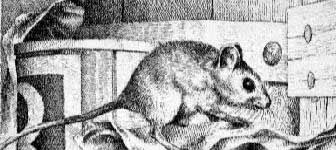 Asleep in my tent one summer night, I was awakened when a mouse ran over my face. I felt the tiny claws as they gripped my skin for a foothold. One mouse that entered the home cabin through the moss chinking of the cabin wall set off my trap without being caught. It became trap-shy and would not go near it again. It rustled about at night and kept me awake. Finally I drowned it using a pail half filled with water on which a light packing case board was balanced, one end resting on the stove sandbox and the other on the pail rim. This literally proved its road to ruin: it spilled the board, bait and itself into the pail as it approached the bait along the board from the sandbox.
Asleep in my tent one summer night, I was awakened when a mouse ran over my face. I felt the tiny claws as they gripped my skin for a foothold. One mouse that entered the home cabin through the moss chinking of the cabin wall set off my trap without being caught. It became trap-shy and would not go near it again. It rustled about at night and kept me awake. Finally I drowned it using a pail half filled with water on which a light packing case board was balanced, one end resting on the stove sandbox and the other on the pail rim. This literally proved its road to ruin: it spilled the board, bait and itself into the pail as it approached the bait along the board from the sandbox.